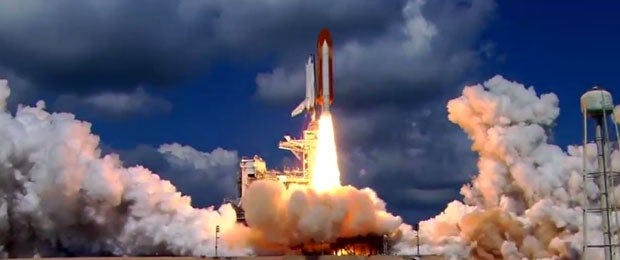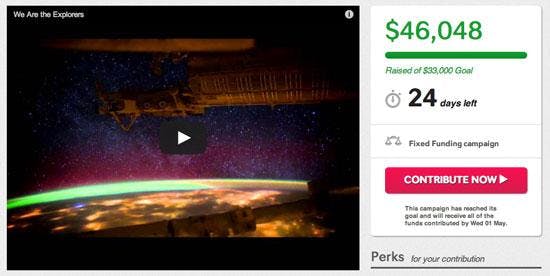Published Apr 7, 2013
Crowdfunding Effort Funds Pre-STID Space Program Trailer
Crowdfunding Effort Funds Pre-STID Space Program Trailer



As a founding member of the STEM education movement, Challenger Center utilizes dynamic, hands-on exploration and discovery opportunities in communities around the globe, engaging more than 400,000 middle school-age students and 40,000 educators each year through simulated space missions that bring their classroom studies to life, and cultivate the skills needed for future success. Because our campaign intends to spark the interest of students and young people, a partnership between AIA and Challenger was a natural fit for this project.What are your responsibilities as Director of Space Systems at AIA?Hendrickson: As the Director of Space Systems I wake up every day thinking of ways to effectively advocate for a strong space program in both the civil and commercial sectors. In many cases that involves writing products like our recent report, Space in Our World, which outlines the countless ways space makes the world safer, smarter, and more prosperous. Fundamentally, though, my job is to tell the incredible story of space and why it matters. Crowdfunding a campaign to get that message to the general public in movie theaters is an exciting new way to tell the story of space.How big a Star Trek fan are you personally? In what ways did Trek inspire you?Hendrickson: I’ve always followed the Star Trek franchise ever since I was hooked by Star Trek: The Next Generation. I think it’s easy to get engrossed in the Star Trek franchise because it presents a future we can all imagine for our own posterity. The tricorder, for all intents and purposes, exists today in the form of the smart phone. We’re sending a vehicle, Voyager, out of the solar system for the first time as we speak. Interstellar travel may not be right around the corner, but the ingenuity and imagination that could make it one day possible is alive and well at NASA and the space industry. Star Trek is an exciting reminder of the next horizon that awaits.

Why do you want the trailer to run before Star Trek Into Darkness? Hendrickson: The possibility of placing of a trailer for space exploration ahead of Star Trek Into Darkness was irresistible. When the Space Shuttle landed for the last time, we noticed that a public misconception seemed to be taking hold that the U.S. human spaceflight program was closed for good. Nothing could be further from the truth; in fact, more vehicles are being developed right now for human spaceflight than at any other point in history. Placing a trailer for Star Trek Into Darkness was the perfect opportunity to show that U.S. human spaceflight is alive and well, and that we’re making real, tangible progress toward an exciting future in space. We can leave audiences with a very simple message: NASA today, Starfleet tomorrow.
Mixing fiction and reality, to your knowledge, what did it mean to the families of the Challenger crew that Star Trek IV was dedicated to those lost in the Challenger disaster?Hendrickson: I can’t speak personally to the reaction of the Challenger crew families, but I’m told by those familiar that the Challenger crew families were pleased with the connection. It’s my understanding that they see these types of tributes as living testaments to the crew’s dedication to exploration. I’d invite you to visit the following website, which also highlights other connections between memorials for Challenger and Columbia and Star Trek (see image eight from the top – the mission patch for the lost Columbia mission and the Enterprise sticker). Keith Cowing of SpaceRef.com is much more familiar, and can probably speak even more to this connection between Star Trek and Challenger. Go to Space Ref.

What inspired you to go the Indigogo/crowdfunding route?Hendrickson: A presentation by NASA’s chief technologist recently highlighted the use of crowdfunding in space projects, which got me thinking we might be able to use that mechanism to harness public support for the space program. There’s some who think the general public is apathetic toward space programs, but I’ve always thought it was quite the opposite - you just need a mechanism for the public to engage and participate. Crowdfunding is the perfect way for the public to stand up and take ownership of our space program, and they did that so in an overwhelming way.How shocked were you by just how quickly the initial goal figure was met? And what does meeting it so quickly tell you?Hendrickson: I was completely overwhelmed by the sudden outpouring of support. We have nearly 1,500 donors and we reached our goal in under a week. We originally intended for the campaign to last over 35 days. This tsunami wave of support demonstrates that the public cares immensely about space exploration, and they’re willing to reach into their own pockets to make sure the next generation is inspired, and ready to pick up the torch. Clearly our future in space is bright.

Which of the gifts that donors can receive are generating the most excitement?Hendrickson: The Space Shuttle mission patches went very quickly. I think people identify with the Shuttle in a similar way as they do the Starship Enterprise – they’re more than just ships, they’re legends in time. You're now at $46,000 and counting, and have a new goal figure. Please explain how the additional funds raised will be used.Hendrickson: We’re aiming to raise $94,000 before May 1st. If we do so, we can purchase an ad in at least one theater in every state in America. That’s an exciting goal, allowing us to reach entire groups of kids that may not have had any prior exposure to spaceflight. If we go above that $94,000, those proceeds will be used to fund educational programs at Challenger Center.
